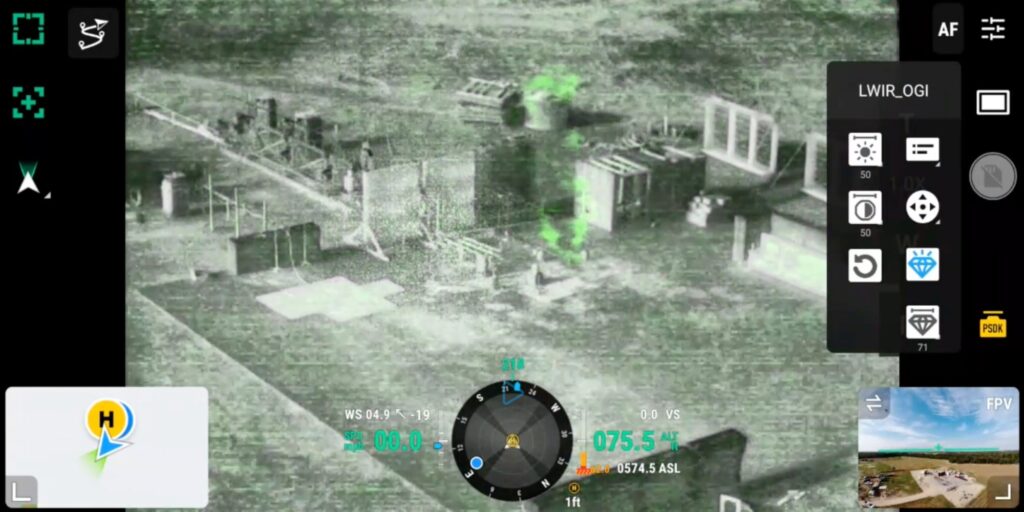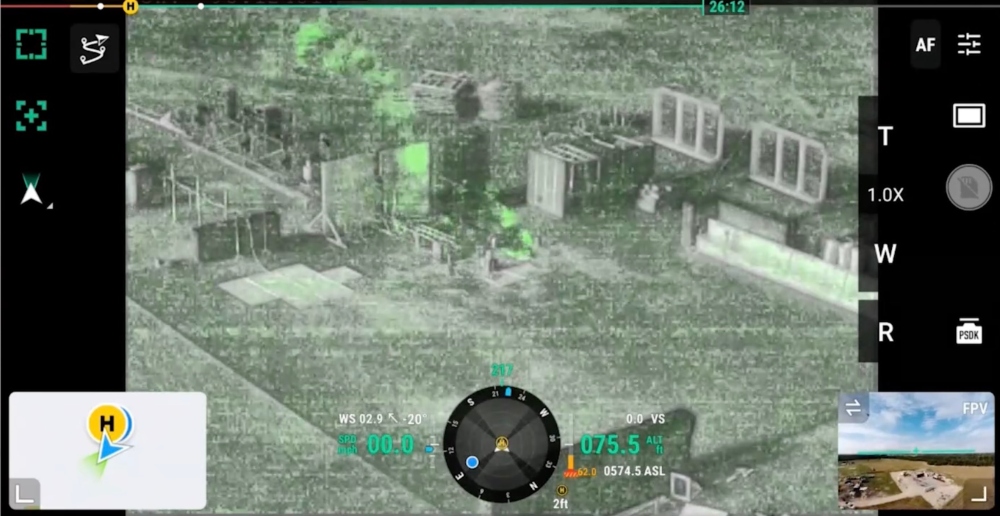
Resources / Case Study / Acuren Partners with MFE for EPA-Compliant, Drone-Based Gas Leak Detection
Case Study
Acuren Partners with MFE for EPA-Compliant, Drone-Based Gas Leak Detection
When a client needed to validate repairs on methane storage tanks, Acuren turned to MFE Inspection Solutions for support. Using a DJI Matrice 350 equipped with MFE’s Detect LW—the first long-wave, uncooled OGI (optical gas imaging) camera designed for drones that complies with EPA OOOOa/b/c—Acuren quickly identified a faulty vent that was still releasing methane, an issue that could have gone undetected with traditional methods.
Benefits
Safer Gas Leak Detection
EPA OOOOa + Appendix K Compliance
Immediate Leak Detection
Introduction
When a client needed to validate repairs on several methane storage tanks, it turned to Acuren for help using optical gas imaging (OGI) compliant with the EPA’s OOOOa and Appendix K.
Methane leaks pose serious risks. They endanger worker safety, inflate regulatory compliance costs, create environmental liabilities, and cut into revenue by releasing valuable methane into the air. Detecting these leaks quickly and accurately is crucial for protecting both operations and compliance.
But ensuring that repairs are successful isn’t easy. Traditional inspections with handheld monitors require workers to climb tanks, exposing them to hazards while only providing limited coverage.
To overcome these challenges, Acuren’s client wanted to find a new way to do gas leak detection.
The Challenge
In validating the repairs on its client’s methane storage tanks, the stakes were high for Acuren and its client.
Even a small leak can compromise safety, release methane directly into the atmosphere, and trigger costly fines for fugitive emissions. Acuren’s client needed assurance that recent repairs—welded seams and a newly installed vent—were holding.
But traditional methods weren’t ideal. Handheld monitors offered only partial data and put workers at risk, while aerial options like helicopters or fixed-wing aircraft were too expensive, imprecise, and unsafe in congested refinery airspace.
And because the EPA’s OOOOa points to Appendix K for OGI performance and operating envelopes, the client needed inspection data that would hold up to regulatory standards—not just imagery from an inspection camera.
The Solution
To tackle the challenge, Acuren turned to MFE Inspection Solutions for guidance.
Together, they selected MFE’s Detect LW OGI camera for deployment on a DJI Matrice 350. The setup gave inspectors the ability to identify methane leaks remotely from the air, in real time.

The workflow required careful planning. The Acuren team set flight parameters—monitoring wind speed, temperature, and distance to the asset—to ensure valid results under EPA Appendix K. By capturing each tank from multiple angles, the drone-mounted OGI camera could reveal visible methane plumes that traditional methods might miss.
This approach promised clear advantages over conventional leak detection:
- Enhanced safety. Inspectors could remain safely on the ground while the drone collected data from above, avoiding the need to put workers in hazardous conditions.
- Faster, more complete coverage. The drone provided broader visibility of assets, capturing leak data from multiple angles in less time than traditional methods.
- Regulatory compliance. Because the Detect LW meets EPA Appendix K within OOOOa/b/c—validated to detect 19 g/hr methane when flown inside Appendix K operating envelopes—operators could generate standards-based evidence to satisfy compliance needs.
MFE’s role went beyond supplying equipment. By providing technical guidance and ongoing training, MFE ensured Acuren’s team could deploy the OGI solution effectively and integrate it into their inspection toolkit.
“The biggest thing for these kinds of inspections is having a compliant inspection method. With the Detect LW we can show that inspections were performed under the right standards, and deliver a report that reflects that. It’s not just about seeing a plume—it’s about having data regulators will accept.”
Michael Spooner, Regional Drone Operations Manager at Acuren
The Results
The drone-based OGI inspection delivered clear, actionable outcomes.
Within minutes of flight time, Acuren validated that two repaired tanks were leak-free and pinpointed a faulty vent on the third that was still releasing methane.

By confirming repairs and identifying an active leak, the team helped the client prevent further product loss, avoid potential regulatory penalties, and strengthen confidence in its maintenance program—all without putting a single worker on top of a tank.
Key results:
- Immediate leak detection. A faulty vent was identified within minutes of inspection.
- Validated repairs. Two tanks were confirmed to be leak-free.
- Safer operations. The mission confirmed leaks could be detected without sending workers onto tanks.
- OOOOa / Appendix K evidence. Flights were conducted within Appendix K parameters, and Detect LW’s validated performance provided compliance-grade proof of repair validation and the active leak at the vent.
- Reduced costs and risk. Prevented lost methane and avoided potential fines tied to methane emissions.
Conclusion: Proving a New Standard for Leak Detection
Acuren’s mission showed that drone-based OGI is not only possible but practical for methane leak detection. MFE played a key role in making the project possible, providing the equipment, training, and technical support Acuren needed to succeed. Together, the partnership proved that drone OGI isn’t just an emerging technology—it’s a new standard for gas leak inspections.“We have a really strong relationship with MFE. Whether it’s training, backup equipment, or getting us set up on new sensors like the Detect LW, they make sure our team can deliver reliable results from day one.” Michael Spooner, Regional Drone Operations Manager at AcurenBy validating repairs and identifying an active leak within minutes, the team demonstrated a faster, safer, and more reliable way to inspect storage tanks. And the implications extend well beyond a single inspection. Drone-enabled OGI improves safety by keeping workers off tanks, increases efficiency with rapid coverage, and delivers compliance-ready data that can reduce fines while capturing lost product. For operators facing growing pressure to manage fugitive emissions, gas detection drones represent a scalable solution that can be applied across refineries, storage facilities, and beyond.
Share
